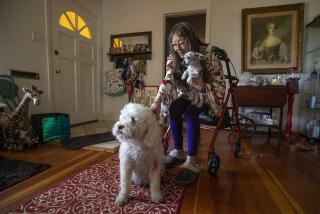Appalachia Elderly Miss ‘Golden Years’ : Health: Disability rates are much higher than average in this poverty-stricken area.
- Share via
MARTHA, Ky. — Perking up at the sight of visitors, 88-year-old Tommy Vanover uncurled and raised himself up on the couch. Even though smiling, he offered a bleak assessment of his health.
“I’m not doing no good,” he said. “I’ve had trouble breathing . . . what is they call it?”
Emphysema, said his nephew. Then Vanover, who in his prime made his living working in construction and digging coal, began talking about a daughter he said lives out back. His relatives confided that the daughter died last August of cancer; Vanover has Alzheimer’s disease too. And arthritis.
“I ain’t been well,” Vanover said. “They want me to go to town to the doctor, but it’s no use. It won’t do no good.”
For Tommy, as for so many Appalachian elderly, there are no “golden years,” only the dark advance of aches and ailments that have mounted over years of hard lives in the poverty-stricken mountains.
A 1990 census survey asked Americans over 65 about limitations that keep them from working, being mobile or caring for themselves. Ranked by county in American Demographics magazine, six of the nation’s 10 counties with the highest percentages of sick elderly were in eastern Kentucky, as were 13 of the 50 highest nationally.
The top 50 list of the sick and old was predominantly Southern, with 49 of the highest-rated counties in Southern or border states. (The highest rate nationally was in Apache County, Ariz., where the majority of residents live on the Navajo Indian Reservation.)
In seven eastern Kentucky counties, more than 35% of the elderly had limitations, compared to a national average of 20.1%.
Such statistics reflect what health care veterans see every day in eastern Kentucky.
“It doesn’t surprise me at all,” said Dr. Grady Stumbo, who operates a clinic in the city of Hindman. “There are a lot of people who had to live most of their lives enduring hard circumstances.”
“There’s no one thing that’s caused it (the high percentage of sick elderly). It’s a multi-factor kind of thing.”
He and Dr. Karen Main, deputy director of the University of Kentucky Center for Rural Health in Hazard, cited a variety of factors tied to the region’s poverty, location and culture:
* Hard-working lives spent on rigorous jobs and with few living conveniences.
“Most of these men and women earned their living using the strength of their backs,” Stumbo said. Two major industries in the region have been coal mining and logging, jobs with “a high degree of injury and wear and tear on the body.”
* Black lung or other respiratory ailments left by years spent working underground in coal mines.
* High-fat diets for many and high rates of cigarette use in a tobacco-producing state.
* Permanent injuries from accidents in the mines, logging, farm work or while driving on hazardous mountain back roads.
* Living in substandard housing, with inadequate sanitation or heating.
* Lack of access to health care and reluctance, because of transportation, economic or cultural reasons, to seek preventive care or early medical intervention.
Stumbo said such procedures as Pap smears, heart catheterization and magnetic resonance imaging have only recently become common in the region.
“For most of these elderly, the services just weren’t available when they were growing up,” Main said.
The bitter fruit is plain to see. Nurse Melissa Vance maneuvers her van along winding mountain roads, making her rounds of home visits for the Christian Appalachian Project, a private organization providing service.
“There’s a lot of breathing problems: asthma, emphysema. And a lot of crippling arthritis,” she said, dropping off food and Christmas presents at the home of a 71-year-old man with aneurysms in both legs.
She sat for awhile at the home of Merte Vanover, 88, whose husband, Charlie, was a cousin of Tommy Vanover; Charlie died of cancer. Merte Vanover has severe arthritis and osteoporosis.
“If she got up, you could hear her joints all over the house. She’s fallen three times since June,” said her daughter, Eva Lee, tears welling in her eyes. “She’s in so much pain.”
There is some reason to hope that the lot of Appalachian elderly will improve. Stumbo said government programs such as Medicaid and Medicare have reduced financial barriers in one of the nation’s poorest regions.
There also has been “tremendous improvement in facilities,” he said, with a network of regional medical centers reducing the hours-long drives faced by residents who had to go to Lexington for hospital care.
The Center for Rural Health, set up in 1990 in the old miners’ hospital in Hazard, augments the new facilities by trying to build up the number of home-grown health practitioners in the region.
“We’re trying to take the education to the region, so they don’t have to leave the region for their education,” Main explained. “Usually once they go away, they don’t come back.”
The center, which offers degrees in physical therapy, clinical lab sciences and nursing, and a family practice residency, has 17 graduates so far--all of whom have decided to stay in eastern Kentucky’s clinics and hospitals.
Such improvements in the region’s health picture will eventually ease the high rates of elderly disabilities, Stumbo said.
“It will take awhile, but I think there are factors in place that in time will decrease that,” he said.
More to Read
Sign up for The Wild
We’ll help you find the best places to hike, bike and run, as well as the perfect silent spots for meditation and yoga.
You may occasionally receive promotional content from the Los Angeles Times.






